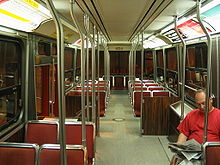Bell cord

In the early days of the tram, a bell cord , bell cord or bell strap served the conductors to signal readiness to depart to the driver .
The bell cord was a cord that ran along the ceiling from the rear door of a tram through several intermediate brackets to the front of the driver's cab , where it rang a bell. The pendulum conductor located at the rear door or in the middle of the car observed the change of passengers at the stops - possibly also with the sidecar - and reported that it was safe to leave by pulling a short pull on the leash.
This facility was particularly widespread in the two-axle vehicles that were used in the past and disappeared with the increasing use of longer units such as open- plan cars or articulated cars or the switch to passenger flow with fixed conductor seats . The bell ropes were either replaced by electrical signal switches or the driver himself took over the supervision of the entry and exit, especially as a result of the increasing spread of the conductorless one-man operation. When converting to schaffner less vehicles this signal switches were again to stop request reconfigured -Signalgebern.
